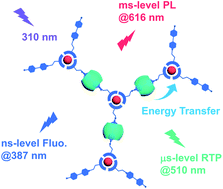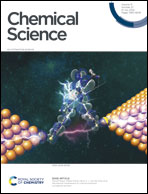A tunable full-color lanthanide noncovalent polymer based on cucurbituril-mediated supramolecular dimerization†
Abstract
The construction of lanthanide multicolor luminescent materials with tunable photoluminescence properties has been developed as one of the increasingly significant topics and shown inventive applications in miscellaneous fields. However, fabricating such materials based on synergistically assembly-induced emission rather than simple blending of different fluorescent dyes together still remains a challenge. Herein, we report a europium-based noncovalent polymer with tunable full-color emission, which is constructed from the 2,6-pyridinedicarboxylic acid-bearing bromophenylpyridinium salt. This rationally designed bifunctional component can concurrently serve as a guest molecule and a chelating ligand to associate with cucurbit[8]uril and europium ions, thus leading to the formation of a trichromatic (red–green–blue, RGB) photoluminescent polypseudorotaxane-type noncovalent polymer in aqueous solution. Meanwhile, the full-color emission enclosed within the RGB color triangle could be readily produced by simply tuning the molar ratio of cucurbit[8]uril and europium ions. The lanthanide supramolecular polymer featuring tricolor emission, long lifetime, high photoluminescence efficiency and low cytotoxicity could be further applied in multicolor imaging in a cellular environment. These results provide a new and feasible strategy for the construction of full-color single lanthanide self-assembled nanoconstructs.



 Please wait while we load your content...
Please wait while we load your content...